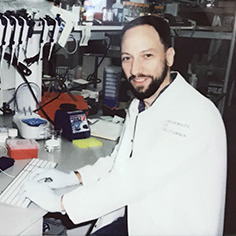Jun 25, 2019
Denaturing agarose gels for large RNAs with glyoxal
- 1University of California, San Francisco
- Stephen Floor Lab

Protocol Citation: Stephen Floor 2019. Denaturing agarose gels for large RNAs with glyoxal. protocols.io https://dx.doi.org/10.17504/protocols.io.4p2gvqe
License: This is an open access protocol distributed under the terms of the Creative Commons Attribution License, which permits unrestricted use, distribution, and reproduction in any medium, provided the original author and source are credited
Protocol status: Working
We use this protocol and it's working
Created: June 25, 2019
Last Modified: June 25, 2019
Protocol Integer ID: 25050
Keywords: RNA, glyoxal, agarose, gel
Abstract
PAGE gels work great for separating small RNAs under 500 nt or so, but cannot separate larger RNAs. This protocol uses glyoxal to denature RNAs, which can then be run on an agarose gel and will migrate according to their length rather than secondary structure etc. These gels work great and are an easier alternative to making formaldehyde gels when trying to separate large RNAs. Glyoxal reversibly reacts with guanine, adenine and cytidine bases in RNA preventing secondary structure formation. It is critical to maintain acidic pH (< 7.0), as the glyoxylation reaction is reversible in basic conditions.
The glyoxal reagent is NorthernMax loading dye from Ambion. http://www.lifetechnologies.com/order/catalog/product/AM8551
There are two steps: pouring the agarose gel and glyoxylating the RNA to be loaded onto the gel. Note that the buffer for this is not TAE! Further note that the loading dye already has EtBR in it so staining is unnecessary, and do not add stain to the gel.
References:
RNA: A Laboratory Manual by Rio, Ares, Hannon and Nilsen (CSHP)
Materials
MATERIALS
ssRNA Ladder - 25 gel lanesNew England BiolabsCatalog #N0362S
Agarose
Ambion NorthernMAX glyoxal loading dyeThermo Fisher ScientificCatalog #AM8551
10X BPTE buffer
- 100 mM PIPES
- 300 mM Bis-Tris
- 10 mM EDTA
- pH 6.5 (RT)
Glyoxylate RNA
Glyoxylate RNA
Mix 500ng to 1ug of RNA sample 1:1 with glyoxal loading dye in ~10 ul
Mix the required amount of ladder 1:1 with glyoxal loading dye
Incubate at 50 degrees for 30 minutes
Note
Note: proceed to pouring gel while glyoxylation reaction is occuring
Snap cool reaction by placing it on ice immediately from 50 degrees to minimize formation of secondary structure
Pouring gel
Pouring gel
Make 1 liter of 1X BPTE buffer (won't use this much but can save the rest).
Make a 1% agarose solution in BPTE and dissolve by microwave
Note
do not add stain to the gel! stain is in the glyoxal loading dye
Pour gel and let cool to RT
Running gel
Running gel
Load samples after 1-2 minutes on ice
Run the gel at around 5V per cm between electrodes (typically ~80V). This usually takes 1-2 hours.
Note
[CRITICAL] Excessive heating may reverse glyoxylation and/or degrade RNA
Image gel using the EtBR channel
Expected result
Numbers on the left are the RNA ladder in kb. Numbers 1-23 on the bottom are different in vitro transcribed RNA samples. Three ladders are loaded. The background smear is normal and not a concern unless there is not a well-defined band at the correct size. Actual concentration of the product can be estimated using densitometry of the full-length band to normalize between samples.
